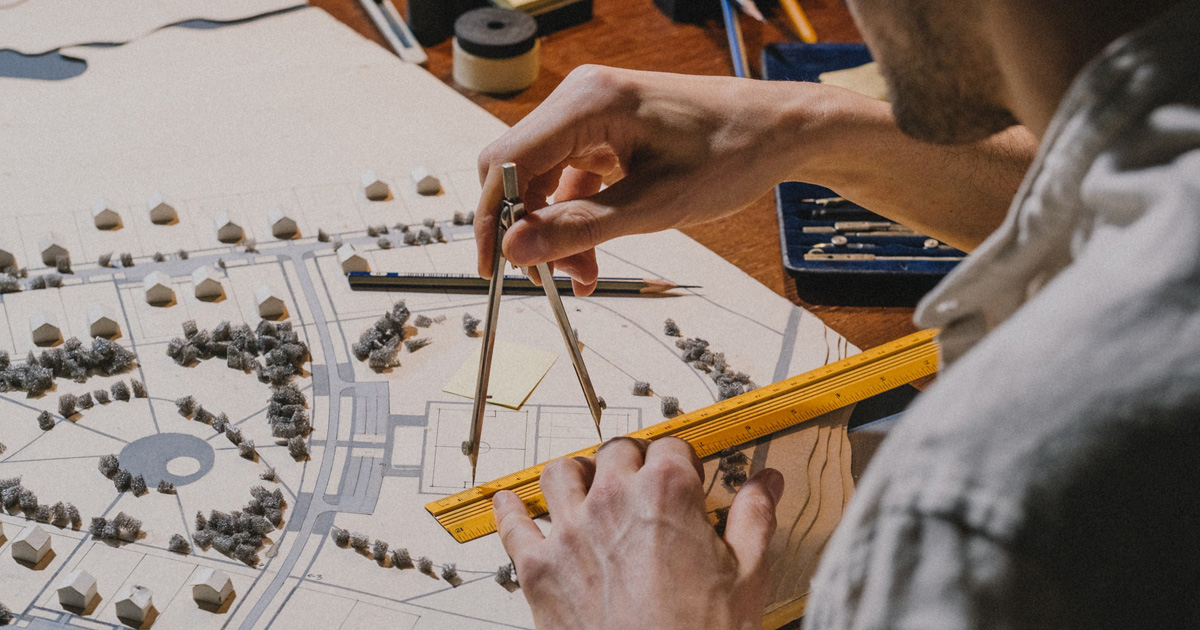Recognizing the Diverse Occupation Paths Available for Aspiring Architect
As a hopeful Architect, you have a globe of career courses waiting for you. Each course uses distinct difficulties and possibilities to use your creative thinking and technical expertise. Whether you're drawn to traditional architecture or the nuances of lasting layout, there's a niche that straightens with your rate of interests. Comprehending these diverse choices can form your specialist journey, however which instructions will you choose to check out first?
Standard Style: Designing Buildings and Frameworks
Conventional design concentrates on developing buildings and structures that mix functionality with aesthetic charm. Your layouts can show social heritage, showcasing local practices while meeting modern-day demands.
You'll develop skills in drafting, model-making, and website evaluation, permitting you to picture and interact your concepts properly. Involving with customers, you'll need to recognize their vision and translate it into feasible designs.
In addition, developing codes and sustainability methods are vital in your job, guaranteeing your structures are environmentally pleasant and secure. As you grow in your job, you'll discover possibilities in property, commercial, or perhaps repair projects, each offering one-of-a-kind difficulties. Embracing standard architecture paves the means for a meeting occupation that pays homage to the past while forming the future.
Urban Planning: Forming Communities and Public Spaces
As a hopeful Architect, you can play a crucial duty as a city planner, changing just how communities function and connect. By utilizing community involvement strategies, you'll ensure that locals have a voice in forming their atmosphere. Plus, incorporating sustainable layout concepts will assist create areas that not just meet today's needs but additionally safeguard the future.
Role of Urban Planners
While several might think about architects as the sole dreamers behind buildings, metropolitan planners play an essential role in shaping the more comprehensive landscape of areas and public rooms. They examine land use, zoning regulations, and neighborhood requires to produce sustainable environments that improve lifestyle. By working together with numerous stakeholders, you'll help make parks, transportation systems, and household areas that advertise social communication and availability. Urban organizers also concentrate on environmental factors to consider, making certain that advancements incorporate eco-friendly areas and assistance biodiversity. Your know-how in spatial layout and community dynamics allows you to visualize future development while preserving social heritage. In this essential duty, you'll directly influence exactly how individuals experience their surroundings, making every project an opportunity for favorable adjustment.
Neighborhood Interaction Approaches
Efficient neighborhood involvement methods are vital for metropolitan coordinators to assure that the voices of citizens are listened to and valued in the planning procedure. To cultivate significant discussion, you should focus on open online forums and workshops where neighborhood participants can express their concepts and issues. Use studies and social media sites to reach a more comprehensive target market, making sure varied viewpoints are consisted of. Teaming up with regional organizations can enhance trust and assist in much deeper connections. It's essential to supply clear details regarding suggested tasks and decision-making processes, allowing homeowners to really feel educated and encouraged. By proactively paying attention and incorporating comments, you'll create rooms that reflect the area's demands, inevitably causing even more successful and sustainable metropolitan atmospheres. Welcome transparency and constant discussion for long-term influence.
Sustainable Style Principles
When creating urban areas, incorporating sustainable style principles is vital for producing atmospheres that thrive both ecologically and socially. Think about integrating eco-friendly spaces, like parks and yards, to enhance biodiversity and boost air quality.
Creating with water conservation in mind is likewise vital-- think of rainfall gardens and absorptive surface areas to handle stormwater. Involving community participants throughout the preparation process warranties that the areas you produce fulfill their demands and encourage social communication. By accepting these concepts, you'll add to vibrant, sustainable city landscapes that benefit everybody.

Landscape Style: Producing Lasting Outside Atmospheres
As you discover landscape architecture, you'll uncover necessary design principles that develop beautiful and functional outside rooms. Sustainable methods play a vital function in guaranteeing these atmospheres flourish while decreasing environmental influence. And also, you'll locate a variety of career opportunities that permit you to make a genuine distinction in just how people engage with nature.
Layout Concepts in Landscape
Recognizing layout principles in landscape architecture is necessary for developing sustainable exterior environments that integrate with nature. You'll need to contemplate elements like proportion, balance, and scale to ensure your styles feel natural and inviting. Including indigenous plants not just enhances biodiversity but likewise reduces water usage, making your landscape durable. Think of the circulation of room and just how people engage with it; pathways and seating areas ought to invite expedition and relaxation. In addition, pay focus to seasonal changes, making with materials that match the environments year-round (Architect). By focusing on sustainability and aesthetics, you can develop exterior spaces that enrich the community and promote wellness. Embracing these concepts will certainly establish a strong structure for your profession in landscape architecture.
Lasting Practices Summary
Lasting methods in landscape architecture not only concentrate on visual appeals however additionally prioritize eco-friendly wellness and source conservation. You can develop rooms that promote dirt health, such as utilizing organic products and exercising permaculture principles. Ultimately, these practices assure your layouts benefit both individuals and the setting for years to come.
Job Opportunities Exploration
With a solid structure in sustainable methods, landscape architecture provides a range of profession courses that permit you to make a meaningful effect on the atmosphere. You could work as a landscape designer, producing visually pleasing and practical outside areas, or specialize in environmental restoration, aiding to revitalize damaged ecological communities. Urban planners typically team up with landscape engineers to develop green rooms in urban settings, improving city livability. If you're passionate regarding education and learning, take into consideration coming to be a landscape design instructor, motivating future generations. In addition, you could deal with nonprofits concentrated on environmental sustainability or take part in research study to innovate brand-new methods. Each course not just shapes stunning atmospheres yet likewise cultivates a much healthier planet for future generations.
Sustainable Layout: Concentrating on Eco-Friendly Practices
As you discover your occupation in architecture, accepting environmentally friendly methods can set you apart in a competitive area. Lasting design focuses on developing buildings that reduce ecological effect while improving resident wellness. By including renewable materials, energy-efficient systems, and sustainable building methods, you'll add to a greener future.
Start by getting knowledge of green qualifications like LEED or BREEAM, which can bolster your credentials. Take into consideration exactly how natural light, ventilation, and thermal effectiveness can maximize design. Team up with designers and environmental consultants to introduce services that minimize waste and conserve resources.
Do not fail to remember the value of area participation-- engaging local stakeholders can inspire layouts that balance with the environment. As clients increasingly focus on sustainability, your proficiency in environment-friendly methods will not just attract tasks but additionally accomplish your passion for liable style. Accept this crucial aspect of the career, and enjoy your occupation prosper.
Historic Conservation: Protecting and Recovering Cultural Heritage
While you begin on your building trip, consider the important duty of historical preservation in maintaining our social heritage. This area focuses on the protection and reconstruction of substantial buildings, websites, and structures that inform the tales of our past. By involving in historic preservation, you'll assist secure the architectural heritage that forms area identification.
As a historical conservation Architect, you'll analyze historical significance and evaluate the problem of frameworks. You'll function closely with guardians and historians to assure genuine remediation methods are utilized. This career course enables you to mix creativity with study, allowing you to develop solutions that appreciate original materials and craftsmanship.
Your job not only adds to sustainability by recycling existing structures but also fosters a sense of satisfaction within neighborhoods. Accepting this course will certainly assist you end up being a guardian of history, preserving the stories and looks that improve our lives.
Inside Style: Enhancing Indoor Spaces
Historic conservation and interior style both share a commitment to boosting the constructed environment, yet they focus on different aspects. While historical conservation emphasizes preserving a structure's social and historical worth, indoor architecture zeroes in on maximizing interior spaces for performance and visual appeals.
As an ambitious Architect, you'll discover that indoor style allows you to blend creative thinking with technological skills. You'll develop areas that not just look good yet additionally advertise convenience and other performance. This area includes understanding how light, color, and materials interact within a room, influencing mood and functionality.
You'll work with numerous jobs, from domestic homes to commercial workplaces, making certain that each atmosphere satisfies the requirements of its occupants. By focusing on individual experience, you can transform insides into useful and motivating rooms, making a significant effect on just how people engage with their environments. Welcome the chance to improve indoor atmospheres and shape the means individuals address live and work.
Industrial Style: Merging Performance With Aesthetics
Industrial style plays a vital function in developing products that flawlessly mix looks with capability, guaranteeing that what you use everyday is not only visually enticing however also sensible. As an aspiring Architect, you can engage yourself in this area, concentrating on designing whatever from furniture to consumer electronic devices. Your job includes comprehending individual needs, materials, and making processes, enabling you to develop cutting-edge options that improve day-to-day experiences.
In industrial layout, you'll frequently collaborate with manufacturers, marketing experts, and engineers, making sure that your styles are not only attractive yet additionally practical. You'll discover to stabilize type and feature, focusing on use without compromising style. By refining your abilities in mapping out, 3D modeling, and prototyping, you'll be fully equipped to bring your ideas to life. This career course offers a dynamic atmosphere where creativity meets functionality, making it a satisfying option for architects thinking about forming the items of tomorrow.
Frequently Asked Concerns
What Educational Accreditations Do I Need to Come To Be an Architect?
To come to be an architect, you'll require a specialist degree in style, generally a Bachelor's or Master's. Furthermore, you'll need to complete a teaching fellowship and pass the Architect Registration Exam to practice lawfully.
Are There Certification Needs for Different Architectural Occupation Paths?
Yes, there're certification requirements for numerous architectural paths. Architect. You'll require to pass exams, total teaching fellowships, and sometimes go after specialized training, depending on your picked emphasis, like landscape design, city layout, or historic preservation
What Software Abilities Are Vital for Architects Today?

Just How Can I Gain Practical Experience While Examining Design?
You can get useful experience by interning at building firms, joining design competitions, offering for neighborhood tasks, or working together with schoolmates on real-world projects. These opportunities boost your abilities and build beneficial links in the market.
What Task Opportunities Exist Outside Typical Design Firms?
You can explore different task chances outside typical architecture like it firms, like metropolitan planning, interior style, landscape architecture, building and construction administration, property advancement, or even roles in sustainability consulting. Each deals one-of-a-kind obstacles and incentives.
Whether you're drawn to traditional architecture or the nuances of sustainable style, there's a particular niche that straightens with your rate of interests.When creating metropolitan spaces, including sustainable design concepts is vital for creating environments that grow both environmentally and socially.As you explore landscape architecture, you'll uncover important layout concepts that develop useful and attractive exterior spaces.Recognizing style concepts in landscape style is necessary for developing lasting outdoor environments that balance with nature.In industrial style, you'll usually collaborate with marketing experts, makers, and engineers, making certain that your designs are not only lovely yet also feasible.